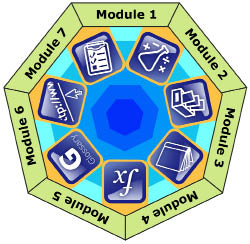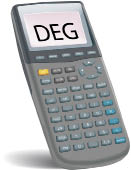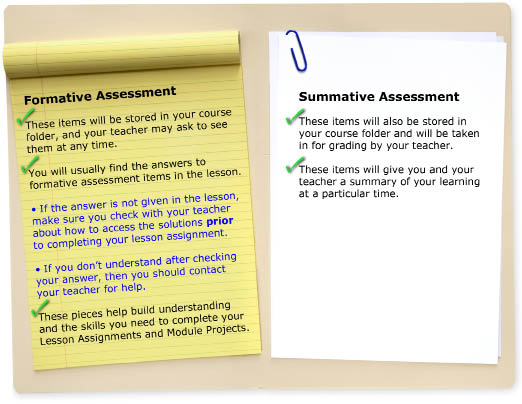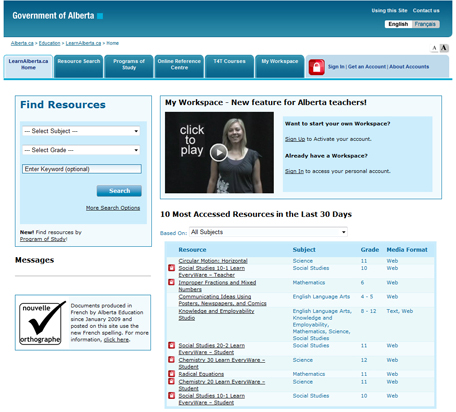Introduction
1. Introduction
Table of Contents
Using the Mathematics 20-2 Folder
Welcome to Mathematics 20-2
In Mathematics 20-2 you will be encouraged to develop positive attitudes and to gain knowledge and skills through your own exploration of mathematical ideas—often with the help of study partners. As you progress through this course, you will also be encouraged to make connections to what you already know from your personal experiences. Building on your own experiences will give you a solid base for your understanding of mathematics.
You will analyze puzzles, games, and patterns and solve problems in order to develop personal strategies. As you progress through this course, you will see that it is acceptable to solve problems in different ways.

Hemera/Thinkstock
The Alberta Program of Studies sets out what students are expected to learn in mathematics courses. These expectations are organized into topics. Under each topic is one or more general outcomes.
The Mathematics 20-2 topics and their general outcomes are shown in the following table. For a complete list of the specific learning outcomes related to Mathematics 20-2, please search “Mathematics 20-2 Program of Studies” on the Alberta Education web page.
Topics |
General Outcomes |
Measurement |
Develop algebraic reasoning and number sense. |
Geometry |
Develop trigonometric reasoning. |
| Number and Logic | Develop algebraic and graphical reasoning through the study of relations. |
| Statistics | Develop statistical reasoning. |
| Relations and Functions | Develop algebraic and graphical reasoning through the study of relations. |
Mathematics Research Project |
Develop an appreciation of the role of mathematics in society. |
Getting Started

- There are seven modules in this course:
-
Modules 1 to 6 are made up of lessons. Each lesson in Mathematics 20-2 is designed to be completed in approximately 80 minutes. You may find that you will require more or less time to complete different lessons depending on your strengths. It is important that you progress at your own pace based on your individual learning requirements.

- Module 7 is the last module of this course. It consists entirely of a project to complete and does not have lessons or lesson assignments. You will find Module 7 on the navigation tree along with the rest of the modules.
- The authorized textbook for this course is Principles of Mathematics 11 (Nelson Education). Note that you will not be going page by page through the textbook as you progress through the course. The majority of instruction in this course is contained within the lessons. You will be guided to specific pages in the textbook to support your learning throughout the course.
- The prerequisite course for Mathematics 20-2 is Mathematics 10C.
-
Your calculator must be set to degree mode for all calculations done in Mathematics 20-2. If you cannot determine how to set your calculator to Degree mode, you will need your calculator’s manual. These manuals can often be found on the Internet by entering your calculator’s make and model number into a search engine.

- You will need access to graphing technology to complete this course.
- You will be asked to complete a number of tasks, including Try This, Share, Lesson Assignments, and Module Projects.
- These tasks will help you to gain an understanding of concepts and apply these concepts to a variety of situations. A full description of each of these tasks can be found in this course introduction under the Course Assessment heading.
- While all tasks are designed to help you learn the material, you will be required to submit only certain items for marks.
- These tasks will help you to gain an understanding of concepts and apply these concepts to a variety of situations. A full description of each of these tasks can be found in this course introduction under the Course Assessment heading.
It is important that you have a discussion with your teacher about how to access the solutions for those tasks that will not be marked prior to completing your lesson assignment.
- All the work you do in this course should be stored in your Mathematics 20-2 course folder. (It will be described as the course folder in each of the lessons.) This folder may be physical or electronic. Your teacher may ask you to submit any items from lessons at any time, so make sure that all work you do is stored in your course folder.
- For clear viewing of equations in Microsoft® Office Word documents, Euclid fonts are required. You can download them from http://dessci.com/en/dl/fonts/getfont.asp if you do not already have them.
Course Assessment
Your work will be assessed in a number of different ways.

iStockphoto/Thinkstock
The Assessment section at the beginning of each lesson provides a list of tasks or items that you are expected to submit. These tasks will be located on the Lesson Assignment document. The Assessment icon will be used as a cue as to which items can be found on the Lesson Assignment document. Save this document to your course folder, and submit it to your teacher when completed.
It is important that you have a discussion with your teacher at the beginning of this course to determine specific assessment requirements he or she may have and how you will be accessing the solutions for those items that are not on the assessment list.
Components
In a typical lesson, you may be asked to complete any of the following assessment tasks or items.
Component |
Description |
Are You Ready? |
This section provides a short pre-test to help you assess your mastery of prior skills and knowledge. If you are successful with these questions, you can move on to the Discover or Explore sections. If you encounter difficulty with these questions, you can move on to the Refresher to review prior skills. |
Try This |
Try This includes opportunities to discover, practise, and apply learned concepts. These can be simulations, activities, or questions. |
Share |
This component provides opportunities for you to reflect, communicate, and build consensus about work completed. Share activities include discussion board postings or conversations with other students or partners. If you don’t have the opportunity to work with other students or post to a discussion board, talk with your teacher to determine alternative approaches. |
Self-Check |
Self-Check provides opportunities for you to check your understanding of concepts learned in the lesson. You can judge by your results whether you need to contact your teacher for help. |
Math Lab |
Math Lab is an activity where you complete an investigation that allows data collection and analysis. |
Lesson Assignment |
Some lessons will have marked Lesson Assignment questions, which can be found on the Lesson Assignment document. Submit your finished work to your teacher when completed. |
Module Project |
There is a project that will be required to be completed for each module. Instructions will be located in the Project Connection section of lessons. |
Course Glossary |
You will create your own version of a glossary in this course. As you encounter new terms, you can add them to the Glossary Terms document. A full description of the course glossary is provided later in this course introduction. |
Formula Sheet |
You will build a formula sheet throughout this course. A full description of the Formula Sheet document is provided later in this course introduction. |
Notes Organizer |
A notes organizer is a tool for recording key concepts, terms, formulas, examples, or tips from each lesson in one place to refer to as you work through the course. Notes can be organized in a variety of formats.
Take a look at the Notes Organizer in the Toolkit for some ideas on how you can set up a notes organizer. |
As stated earlier, it is important to save all assessment items in your course folder.
Hints and Rhetorical Questions
![]() You will come across hint buttons.
You will come across hint buttons.
When you do, float your mouse over the button to access a hint.
![]() Sometimes you will be asked a question that is intended only to get you thinking.
Sometimes you will be asked a question that is intended only to get you thinking.
These are rhetorical questions—you are meant to answer these questions in your head only. You can check your answer by rolling your mouse over the Answer button.
Visual Cues (Icons)
You will see icons throughout the course. These icons are clues regarding the type of activity you are about to begin.
Assessment |
Caution |
Formula Sheet |
Glossary Sheet |
iSearch |
Notes Organizer |
Math Lab |
Textbook |
Course Folder |
|
|
|
Using the Mathematics 20-2 Course Folder

Hemera/Thinkstock
The Mathematics 20-2 course folder is where you store your work. It gives you an ongoing record of your efforts, achievement, self-reflection, and progress throughout the course. When you want to show your friends or family what you’ve been learning, your work is all there for them to see. You may also have the opportunity to select your best work for grading. You may find your course folder useful in preparing for tests, quizzes, and your module project.
Course Glossary
You will create your own glossary in this course. In Module 1: Lesson 1 you will discover the Glossary Terms document. Throughout the course, you will add new terms to the glossary and keep it in your course folder.
You will find the definitions to these terms in the lessons themselves, as well as in your textbook. You can further enrich your understanding of these terms by using the Internet or sharing ideas with other students. The glossary is intended to be personal. You should define terms in a way that makes sense to you. You can add examples of how those terms are used. These examples can be in the form of diagrams, illustrations, or worked problems.
You may open and start a new Glossary Terms document for each lesson that you complete. Or you may wish to create one Glossary Terms document for Module 1 that can be used for the entire course by adding new terms you encounter in each module to the same document.
Formula Sheet
On the Formula Sheet document, you will create a list of all the formulas you use in each module with a description of the terms and perhaps a diagram.
You may open and start a new Formula Sheet document for each lesson that you complete. Or you may wish to create one Formula Sheet document for Module 1 that can be used for the entire course by adding new formulas you encounter in each module to the same document.
Notes Organizer
A notes organizer is a tool for recording key concepts, terms, examples, or tips from each lesson in one place to refer to as you work through the course. Notes can be organized in a variety of formats. Take a look at Notes Organizer in the Toolkit for some ideas on how you can setup a notes organizer.
Toolkit
The Toolkit in Mathematics 20-2 Learn EveryWare a collection of resources that provide you with further explanations or guidance for completing activities and assignments. The Toolkit may consist of grid-paper templates, spreadsheets, Math Lab templates, virtual manipulatives, videos, and other objects to assist you as you work through each lesson.
Learning Environments
Mathematics 20-2 students will be completing this course in a variety of learning environments, including traditional classrooms, online/virtual schools, home education, outreach programs, and alternative programs.

left © Lorraine Swanson/2411326/Fotolia; centre © senai aksoy/10736813/Fotolia; right © goodluz/30420227/Fotolia
This course is delivered to you in an online environment. You can look forward to using resources, such as interactive multimedia and the Internet, for various activities. You will also have access to computer simulations, computer multimedia, computer graphics, and electronic information to support your learning.
Remember that exploring the Internet can be educational and entertaining. However, be aware that these computer networks may not be censored. You may unintentionally come across offensive or inappropriate articles on the Internet. With that in mind, be aware that perspectives presented on the Internet are there for you to analyze critically and to accept or reject based on that analysis. Since information sources are not always cited, you should always confirm facts with a second reliable source.
Some school jurisdictions may limit access to social networking sites. In such circumstances, you should consult with your teacher, as your teacher may need to adapt lessons to accommodate co-operative learning.
LearnAlberta.ca
LearnAlberta.ca is a protected digital learning resource environment for Alberta students. This Alberta Education portal, found at http://www.learnalberta.ca/, is a place where you can support your learning by accessing the online version of Mathematics 20-2 Learn EveryWare along with resources for projects, homework, help, review, or study.
For example, LearnAlberta.ca contains a large Online Reference Centre that includes multimedia encyclopedias, journals, newspapers, transcripts, images, maps, and more. The National Geographic site contains many current video clips that have been indexed for Alberta Programs of Study. The content on LearnAlberta.ca is organized by grade level, subject, and curriculum objective. Use the search engine to quickly find key concepts. Check this site often as new interactive multimedia segments are being added all the time.
To access some of the resources on LearnAlberta.ca, a password may be required. If you find a password is required, contact your teacher or school to get one. No fee is required to use LearnAlberta.

Mathematics 20-2 Partners
 |
 |
||
 |
 |